Modern life demands flexibility, as shrinking homes, faster travel, and evolving lifestyles outpace the limits of rigid, traditional design. Conventional rigid structures struggle to keep up with this pace, but inflatable design offers a refreshing solution. Imagine furniture that folds into a backpack, or homes that expand and contract with your lifestyle.
Inflatables merge creativity with convenience, giving us spaces and products that are lighter, more portable, and more versatile than anything we have known. Beyond novelty, this design approach directly addresses modern challenges, turning adaptability into a tangible experience. Here is how inflatable design invites us to consider solutions created for living, rather than for permanence alone.
1. The Shift Toward Sustainable, Lightweight Design
The materials we use directly shape the environmental impact of our homes and products. Traditional construction relies heavily on materials like concrete and steel, which require substantial energy for manufacturing and transportation. Inflatable design, by contrast, relies on engineered fabrics that are durable and lightweight.
Whether used for a temporary pop-up structure or adaptable furniture, their reduced weight significantly lowers the energy required to move, assemble, or reconfigure them. But the benefits extend further. Inflatable structures achieve similar volume and function with far fewer raw materials, resulting in leaner production, less waste, and a smaller carbon footprint.
Z LOUNGER proves inflatable seating can be both stylish and ergonomic. Airmaan’s Kickstarter success folds into a yoga-mat-sized roll yet unfolds into a silhouette closer to Le Corbusier’s Chaise Longue than a pool float. An S-shaped contour supports the spine, internal air chambers align with natural curves, and a detachable neck pillow adds comfort. The reclining base adjusts easily between upright lounging, full recline, and flat mode, while a subtle knee arch improves posture and circulation.
Weighing just 4.6kg, it’s portable yet built to withstand tough conditions, with military-grade composites that resist UV, rain, pets, kids, and even accidental run-overs. Inflation takes under a minute, it’s waterproof, mildew-resistant, and doubles as a floating lounger. Modular by design, it accommodates aftermarket mats while offering Airmaan’s own Z Cushion.
2. Adaptability for the Modern Lifestyle
Modern life is constantly shifting as we relocate for careers, family, or simply the pursuit of change. Traditional homes, built as static fixtures, rarely match this fluid reality. Inflatable spaces, from rapid-deploy shelters to pop-up event venues, offer an agile solution. Easy to assemble and just as easy to store, they provide flexibility for disaster relief, temporary housing, or even a home office that disappears once work ends.
This adaptability also enhances everyday living. In small apartments, large furniture can feel restrictive. Inflatable alternatives deliver the same comfort yet can be packed away, freeing space for yoga, gatherings, or creativity.
In design, inspiration often emerges from the most unexpected sources. The SQUEEZE lamp, created by designer Eva Ausmann, exemplifies this by reimagining air as a central design element in lighting. More than a lamp, it is an inventive exploration of material and form. Constructed from TPU-coated nylon, the piece maintains constant air pressure, resulting in a structure that is both lightweight and resilient. At first glance, its playful form could be mistaken for decorative art, yet its inflatable body and welded joints give it both flexibility and strength.
SQUEEZE integrates functionality with innovation. It attaches to tabletops using pressure between air cushions, while an integrated air-pressure sensor enables light control through touch, creating an interactive experience. Designed for sustainability, the lamp folds flat when deflated, reducing weight, transport costs, and emissions. Available in three colors, its minimalist geometry and soft contours allow it to complement diverse interiors, blending playful creativity with refined sophistication.
3. Enhanced Well-Being Through Sensory Design
The experience of a space is defined not only by appearance but also by touch and form. While we often connect well-being to natural light or fresh air, the sensory qualities of our surroundings are equally important. Inflatable design brings a new tactile dimension with soft, pliable surfaces that feel welcoming and gentle. Unlike rigid interiors, these elements create a relaxed, comfortable atmosphere that supports mental balance.
The shapes themselves add to this effect. Rounded edges and fluid, playful forms reduce intimidation, replacing sharpness with calm.
The Esch 22 Space Station 04 E22SSPIU, or short for “Pump It Up,” is a conceptual towable dwelling that inflates an upper level to accommodate up to six occupants. Conceived by Luxembourg-based studio 2001 for the city of Esch, the project functions as a research initiative rather than a commercial product. Its purpose is to provoke discussion about unconventional approaches to compact housing. The unit is constructed on a durable stainless steel double-axle trailer with a restrained exterior design, punctuated by a single, expansive rear window that introduces natural light and frames exterior views. Entry is provided by a metal ramp leading to a lower-level interior containing a living area, bathroom, and compact kitchen with essential amenities.
Once stationed, pneumatic struts elevate the roof to form a base, while a compressor inflates a double-shell dome that serves as the upper floor. This level offers cork flooring, integrated light-permeable grating, and inflatable mattresses for adaptable sleeping arrangements. Access is available via staircase or elevator, and a water recycling system supports sustainable use of resources. Though unconventional in form, the dwelling illustrates a creative exploration of adaptable housing strategies within limited space.
4. Intersection of Function and Aesthetics
For years, inflatables were seen as purely practical or playful novelties with little design value. That perception is changing as contemporary designers harness advanced materials and smart engineering to elevate them into high-design objects. Today, we see sculptural chairs, modular walls that shape interiors, and striking architectural features that prove inflatables can be both useful and beautiful.
This transformation highlights how design can merge functionality with inspiration. A translucent inflatable wall, for example, can brighten and expand a room while offering flexible layouts. Inflatables now demonstrate that practicality and aesthetic refinement are not opposites but powerful partners in innovation.
The film lighting industry has embraced many innovations, but few combine practicality and creative flexibility as effectively as ColorPipes. These inflatable, ultra-light fixtures are designed by filmmakers for filmmakers, addressing the frustrations of traditional rigs like heavy equipment, fragile parts, and complex power needs. By weighing a fraction of conventional lights while delivering professional-grade brightness, ColorPipes streamline setup and transport, allowing crews to focus on storytelling rather than logistics. Their pixelized RGBWW technology offers high-CRI bicolor illumination and dynamic color effects, reducing the need for multiple fixtures and empowering creators with greater control over mood and atmosphere.
Built for demanding environments, ColorPipes feature IP67-rated waterproofing, ensuring reliable performance in rain, salt spray, and even shallow underwater shoots. Wireless control through CRMX, DMX, or Bluetooth further enhances adaptability, while the quick-inflation system enables deployment within minutes. Compact enough to fit in a carrying case yet powerful enough for studio-quality output, ColorPipes redefine modern film lighting by merging resilience, versatility, and efficiency.
5. Democratizing Space and Design
Traditionally, creating an additional room or structure demanded permits, skilled labor, and heavy costs, making customization an exclusive luxury. Inflatable design overturns this model by offering lightweight, portable structures that arrive in a box. Instead of lengthy construction, a functional space can be set up within hours, making adaptable and thoughtfully designed environments accessible to far more people.
From temporary art pavilions and pop-up stores to flexible work hubs, inflatables deliver low-cost, high-impact solutions. They allow individuals and communities to experiment freely with layouts and uses of space. Inflatables don’t just change how we build, but they also empower everyone to design.
In Jinan’s streets, a massive soap-bubble-like dome rises above the skyline. Far from being an art installation, it is the world’s largest construction enclosure, an inflatable structure covering 20,000 square meters and soaring 50 meters high. Created by China Energy Construction Group and Licheng Urban Development Group for the Honglou 1905 project, it redefines how construction unfolds in urban spaces.
The dome’s design turns building sites into quieter, cleaner environments by trapping 90 percent of dust and cutting noise by 80 percent. For residents, it eliminates the usual disruption of dust, debris, and relentless noise. Inside, crews work in a climate-controlled space where wind, rain, or weather delays are no obstacle, enabling faster progress and higher-quality results. The dome’s temporary design makes it especially innovative. Once construction wraps up, it simply deflates and disappears, leaving no trace. This reversible approach minimizes pollution, cuts carbon footprints, and redefines urban development.
Inflatable design is not just a trend but a shift in how we shape living and working spaces. By prioritizing adaptability, sustainability, and well-being, it responds to modern needs with intelligence and ease. This fluidity creates freedom that empowers people to design environments that evolve as their lives change.
The post Using Air to Build: How Inflatable Design Is Revolutionizing Habitable Spaces And Product Design first appeared on Yanko Design.

